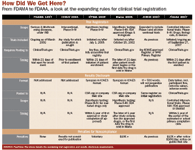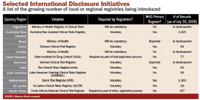Publish or Perish
FDAAA means that you need to register clinical trials-and not only for publication planning
Once upon a time, the very existence of a clinical trial was considered confidential, and sponsors would disclose new findings only after they had passed the rigors of the traditional biomedical peer review publication process. In recent years, however, there has been a groundswell of public criticism—and several highly publicized lawsuits—surrounding industry practices related to information from clinical trials. That has translated into a complex web of regulations and guidance that govern the registration of clinical trials and disclosure of results—and that ultimately have the potential to affect how data are published.
As wave after wave of deadlines send companies scrambling to meet these new rules, the industry is taking a crash course in compliance. And with the next deadline at the end of this month (requiring trial sponsors to post basic results information on ClinicalTrials.gov), pharmas are realizing that this is just the beginning. A gathering storm of international regulations has appeared on the horizon, with different countries setting out different, and often conflicting, requirements for trial registration and results disclosure.
What are the implications of these regulatory changes? Here we outline the emergence of new regulations in the US and beyond, examine the industry's response to date, and suggest how companies might best future-proof their compliance strategy to stay up-to-date with these rapidly emerging requirements in a cost-effective manner.
Clinical Data Disclosure: How Did We Get Here?
Starting in the late 1990s, patients and their advocates led the charge for more information about clinical trials, mostly because they wanted to participate in actively recruiting trials that could offer the potential for life-saving drugs. This was a perfectly reasonable goal, but the drive for more information may have touched off the firestorm of compliance challenges.
Opening round: Drug trials to treat life-threatening conditions The first step toward regulating the disclosure of clinical trial protocols came in November 1997, when the US government signed the Food and Drug Administration Modernization Act (FDAMA) into law. FDAMA covered a wide range of provisions, including the extension of the Prescription Drug User Fees. But Section 113 (which remains in full force today) required the establishment of a "clinical trials databank" that would serve as a centralized information repository on clinical trials for drugs intended to treat serious or life-threatening conditions. Patients were the anticipated audience, but it was also thought that it could be of use to researchers and healthcare providers. The databank eventually emerged in February 2000 as the National Library of Medicine (NLM) Web site, ClinicalTrials.gov.
Medical journals step in In September 2004, the International Committee of Medical Journal Editors (better known as ICMJE, and previously known as the Vancouver Group) weighed in. This working group of editors from 11 highly influential medical journals (including the British Medical Journal and the New England Journal of Medicine) announced that if sponsors wanted to publish results in their journals, they had to register all Phase II through Phase IV studies before enrolling their first patient.
In particular, ICMJE wanted more transparency on clinical trials that "reflect unfavorably on a research sponsor's product." They were concerned about under-reporting of "negative" results—a longtime problem in clinical research, as it tends to distort the body of scientific evidence. For the first time, there were material consequences should sponsors fail to register trials; companies that wanted their study results to remain eligible for publication had to comply. In the months preceding the ICMJE-imposed September 2005 deadline for trial registration, the number of studies registered on ClinicalTrials.gov jumped from 13,153 to 22,714, as companies scrambled to meet the requirements.
Since then, ICMJE has updated its position on several particulars, but the core principles remain in effect—register or perish, perhaps? (See "How Did We Get Here?")

How Did We Get Here?
Maine adds teeth—and results disclosure In June 2005, the state of Maine enacted legislation requiring both trial registration and disclosure of results of any Phase II through IV clinical trials initiated after October 15, 2002, for any drug prescribed, dispensed, or promoted in the state. The law allowed sponsors to register these trials on their Web site or at ClinicalTrials.gov, but also required them to post a summary of trial results in the International Committee of Harmonization E3 (ICH-E3) format—which dictates the content and format of information—within one year of study completion. The legislation states that companies must post these data on a publicly accessible Web site. Many sponsors have met this requirement by posting to the industry-sponsored Web site, ClinicalStudyResults.org, while others simply post summaries to their own clinical registry Web site. Still others do both. Maine also added a $10,000 penalty for non-compliance—the first monetary sanction in this escalating series of regulations. The law remains in effect.
FDAAA: A strengthened Federal mandate Lastly—at least so far—the US government signed the FDA Amendments Act (FDAAA) into law in September 2007. Like FDAMA, FDAAA is broad in focus, but its implications for clinical trial disclosure are clear—more information is required for more trials, and results are officially demanded.
Title VIII of FDAAA expanded the registration requirements from FDAMA's original 113 regulations in two ways. First, the scope of trials covered is dramatically increased to include all controlled interventional trials in patients. Trials for medical devices are required in addition to those in drugs, biologics, and for all conditions. Only Phase I trials are excluded. Second, the required data elements for registration have been expanded to include, for example, detailed intervention data, a primary outcome completion date, and primary and secondary outcome measures.
FDAAA further mandated that beginning in September 2008, and expanding in each of the two subsequent years, the results of clinical trials for approved drugs and devices will be publicly disclosed on ClinicalTrials.gov, and should include detailed tables of data on participant flow, primary and secondary outcome measure results, serious and frequent adverse events, and eventually technical and lay results summaries.
Finally, noncompliance comes with both monetary penalties and, perhaps more important for a company's image, public "shaming" on a government Web site. The government also increased monetary penalties to $10,000 per violation, up to $10,000/day for uncorrected violations after 30 days.
International initiatives More countries are now following the lead of the US with active or pending initiatives surrounding clinical data disclosure. In some countries, these initiatives are voluntary, but many countries are moving toward mandatory requirements as a component of the regulatory submission process.
Nations such as Brazil, Australia, China, New Zealand, and Croatia have already stated their plans to implement registry requirements in the near future. (See "Selected International Disclosure Initiatives") In Europe, sponsors must submit clinical trial information to the European Union Drug Regulating Authorities Clinical Trials, or EudraCT, a database of all clinical trials in Europe. While access to this database is currently restricted to European regulators, information covering pediatric studies is expected to be made public—tentatively scheduled for Q1 2009. In coming months and years, new international regulations and registry requirements from many more countries will become law, each presenting its own set of compliance requirements and its own mechanisms for updating its portal Web site.

Selected International Disclosure Initiatives
Industry Responding as Best It Can
The pharmaceutical industry has made many significant changes to both its public face and its internal business processes in order to comply with the spirit and the letter of the emerging regulations. In January 2005, in response to the early trial registration initiatives and perhaps in anticipation of regulation on results, the leading biopharma industry associations published the "Joint Position on the Disclosure of Clinical Trial Information via Clinical Trial Registries and Databases." This gave rise to ClinicalStudyResults.org (csr.org), a Web portal for results disclosure. The position statement also committed member companies to register all non-exploratory clinical trials, and to disclose a results summary in ICH-E3 format within one year of study completion for trials of approved drugs, or within one year of first commercial availability. The only exception would be if such disclosure would compromise publication in a peer-reviewed journal.
It's also worth noting that seven of the top 10 biopharma companies see public disclosure as important enough to warrant a link from their corporate home page, and most have placed a public statement of their disclosure practices on their Web site. Many have also replicated their trial registry and results disclosure information directly on their corporate Web site, thereby showing a public commitment to the process. (See "Big Pharma's Registry Response")

Big Pharma Registry Response
However, adhering to the process has been a struggle for the industry. Although biopharma companies are now reallocating staff and funding to manage the process, many are finding it challenging to remain in compliance when it comes to providing data in the required time frame. This will only worsen as the weight and complexity of the mandate to publish or perish grows.
Other challenges include:
Lack of harmonization Global harmonization of clinical trials registration is a challenge at many levels, particularly when it comes to what data are to be reported, when, and how sponsors can interact with the Web portals.
The World Health Organization (WHO) hopes to establish a number of harmonization initiatives surrounding the disclosure of clinical trial results, including norms for data elements and responsible parties, a network of primary trial and results registers, a one-stop "meta-search engine" that can search across all global registries in the WHO network, and a mechanism for a single, unique-trial identification number to avoid confusion among site searchers. However, these measures appear to be moving at a much slower pace than the emergence of new national or regional clinical data disclosure initiatives.
Challenge to peer-reviewed publication process Publication in peer-reviewed biomedical journals remains one of the most respected channels of novel clinical findings from sponsor to physicians. However, the current requirement to post trial results within 12 months of "last patient, last visit" has put increasing pressure on the peer-reviewed journal publication processes.
Current data analysis and internal reporting processes, combined with often lengthy peer review and publication lead times, make it almost impossible to secure primary publication of clinical trial results prior to the obligation to post within the 12-month deadline. If the industry and medical journals want to see clinical trial results first published in peer-reviewed publications, they need to reduce cycle times so that primary publication might precede registry posting.

"WHO 20"
Concerns over the "non-promotional" public summaries As early as September 2010, FDAAA will require trial sponsors to post a "non-promotional summary" of each trial and its results expressed for both technical and lay audiences as part of the disclosure requirements. But compliance is fraught with challenges. After all, is it considered promotional if a company states that the trial met its endpoint and confirmed that the intervention exceeded response by the comparator? Most stakeholders would prefer to see the first disclosure of new clinical findings in a report that has been rigorously peer-reviewed, rather than one that is simply a synopsis of data.
Future-Proofing Compliance Strategy
In this confusing environment, how can companies develop a robust yet flexible approach to this compliance challenge? The best strategy seems to combine process, people, and platform.
Process Now more than ever, companies must ensure that their standard operating processes are up-to-date, and that they can accommodate the anticipated growth in clinical trial registries throughout the world. Acceptable process cycle and response times must be clearly articulated, with escalation paths to manage delays. Implicit in this is a thorough examination of the cycle times to prepare data for publication or disclosure, including time to database lock and final clinical study report.
People In response to the challenge of facilitating global compliance, many leading biopharma companies are adopting a combined centralized/decentralized approach that maps to the realities of this business process. It will be challenging to keep pace with evolving US and global requirements. As a result, many companies have elected to form a small internal team of "process" experts that are charged with keeping current with emerging requirements. These process experts will work closely with globally dispersed "content" experts who are familiar with the status of each clinical trial and the emerging data.
Platform The ever-increasing scope and complexity of this compliance process has led most companies to the realization that a manual process—relying on e-mail and spreadsheets rather than a workflow and project management system—is simply unsustainable. Companies looking for a platform to support a high quality trial registration process that is transparent, auditable, secure, and robust typically require at least the following capabilities:
» A secure Web-based system to facilitate global access
» Configurable workflow capabilities that support role-based, managed-approval chains
» Integration with a range of internal systems, including clinical trial management system (CTMS) and results repositories
» Integrated reporting, both status and process metrics
» Automated e-mail notifications, driven by both workflow and escalation triggers
» A validated system to insure quality
It's evident that most companies are looking to buy—rather than build—these systems, as they consider the evolving regulations too fluid to risk internal or custom development. If that's the case, organizations should look for a partner with internal process expertise to ensure that requirements evolve at pace with the environment, managed hosting, and strong implementation capabilities.
However you plan to respond to the ever-changing requirements for clinical trial information, it is vital that you move quickly to formulate and implement an effective compliance strategy. After all, it's fairly certain that companies can never return to the "Once upon a time" days when clinical trials remained a secret until the company decided it release the results. Indeed, the rules and regs governing clinical trial mostly like will become all the more complex in the future.
Tim Bacon is president and CEO of PeerView and a founding member the International Society for Medical Publication Professionals. He can be reached at Tim.Bacon@epeerview.com.
Melanie North is vice president of compliance and program management for PeerView. She can be reached at Melanie.North@epeerview.com.

Addressing Disparities in Psoriasis Trials: Takeda's Strategies for Inclusivity in Clinical Research
April 14th 2025LaShell Robinson, Head of Global Feasibility and Trial Equity at Takeda, speaks about the company's strategies to engage patients in underrepresented populations in its phase III psoriasis trials.
Key Findings of the NIAGARA and HIMALAYA Trials
November 8th 2024In this episode of the Pharmaceutical Executive podcast, Shubh Goel, head of immuno-oncology, gastrointestinal tumors, US oncology business unit, AstraZeneca, discusses the findings of the NIAGARA trial in bladder cancer and the significance of the five-year overall survival data from the HIMALAYA trial, particularly the long-term efficacy of the STRIDE regimen for unresectable liver cancer.
Expanding Immune Response Testing to Support Vaccine Development
April 22nd 2025Nigel McCracken, chief operating officer, Virax Biolabs, discusses the expansion of its ViraxImmune platform into areas such as transplant monitoring, vaccine efficacy, latent virus reactivation, and CAR T cell therapy.